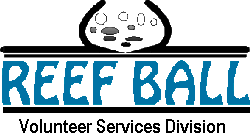

|
The Reef Ball Foundation Coral Team has developed rapid response teams using trained volunteers often with the assistance of local experts to be able to provide an very fast response to hurricane damage on coral reefs. For a period of day and for about 6 months after a hurricane, there will typicaly be a large number of coral fragments that are laying in sand (fragments on hard bottom can recover naturally and should not be touched) that will die over time and waves bury them into the sand. By being proactive and re-attaching these imperiled coral fragments reef systems can recover faster from Hurricane events. Often, additional complexity in the form of designed artificial reef modules can aid in providing fish habitat until the coral have a chance to recover to offer this time of complexity again. This type of work can be especially important when the reefs destroyed by the hurricane have a high social or economic value such as reefs traditionally visited by tourists or for used by local fisheries. (Click here if you are in Florida and find hurricane damage to a reef) |
|
Quick
Artificial Reef
Monitoring and Activities Near You (Reef Ball World Mapping System) |
Steps in A Reef Ball Foundation Hurricane Recovery
Project
An on-going monitoring program is optionally put into place to
document the recovery of the reefs after the hurricane. Locals are often
involved in this effort. |
Want Information About Volunteering & Current
Projects?
Just enter your email address and hit submit
|
Need more information? Contact us:
|
||
|
|

Reef Ball Foundation, Inc., Georgia Office (Kathy Kirbo) Florida Office (Todd Barber)
|
|
|
Copyright ©1993 - 2004, Reef Ball Foundation, Inc. all rights reserved. See brochure page footer for information on patents, copyrights, trademarks and service marks referenced, but not indicated, on this page. |
Other Valuable Internal Reef Ball Links
Reef
Ball World Mapping System-NEW
-Project Summaries, News, Coordinates, Coordinators, Contractors, ETC by
Location!
News
Articles in the Press
-Maiden
Island Antigua Total Reef Restoration Project Press Release.
-Coral
Reef Transplant Notes
-Identified
Hard Coral Diseases (The
Coral Disease Page) offline